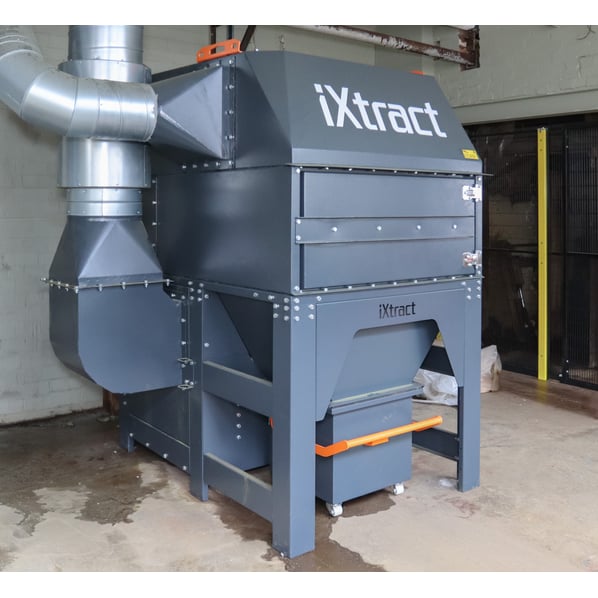iXtract Ltd H2 Reverse Pulse Dust Extractor


Direct From Site Clearance
- Direct Site Clearance Price [?]
- £ Login or Register for price
- Clearance ends
- 31 January 2026 12:00 GMT while stocks last
- Part of a Direct Site Clearance
- World Leading Filtex Dust Extractor Clearance
- Condition
- From a working environment, Excellent Condition, Current Model
- Stock No
- EE2258
- Manufacturer
- iXtract Ltd
- Model
- RPF H2
- Year of Manufacture
- 03/2024
- Serial
- 0037-008-004
- Condition
- From a working environment, Excellent Condition, Current Model
- Approx Duty CFM / M³/Hr
- 2726 // 4633
- Filter Area ft² / m²
- 40M2 Standard : 68M2 Nano Fibre Filters
- Other Info
- 100L Bin Capacity : 2 Filters
- Location
- Our Central Warehouse, Aldridge, UK
- Weight (kgs)
- 552
- External Dimensions (WxDxH mm) [?]
- 1200 x 1800 x 2220mm
- Delivery Your delivery options
Description
The iXtract reverse pulse filter is an air filtration system designed to remove dust and particulate matter from industrial processes. It employs a reverse pulse cleaning mechanism, firing pulses of compressed air down the filter cartridges to dislodge and collect accumulated contaminants, ensuring continuous and efficient operation.
The horizontal reverse pulse filter units consist of a series of filter cartridges arranged horizontally within the main housing. Contaminated air is drawn through the filters where particles are captured on the outer surface. As dust accumulates, the filter unit measures the pressure differential between the clean side of the filter and the dirty side.
Once a programmed set point is reached, the filter unit then initiates a controlled blast of pneumatic airflow down the centre of each filter individually and sequentially. This sudden burst of air dislodges the accumulated dust, causing it to fall downwards into the collection bin below. All this is carried out automatically without operator interaction.
Features
- Modular design
- Continuous operation
- High filtration efficiency
- Compact footprint
- Reverse pulse jet cleaning
- Easy access doors for filter maintenance
What is Dry Dust Extraction?
The most popular dust extraction method, dry dust extractors collect dust using filters and cartridges. Known for processing large volumes of air when filtering medium/large dust particles such as wood, flour, and metals.
They typically include a cleaning system to discharge the dust gathered within the filters and cartridges, they carry out a shaker cycle or reverse pulse cycle to free the collected dust and empty it into a removable storage bin.
What are Reverse Pulse Jet Dust Collectors?
Reverse Pulse Jet Dust Collectors use a jet of air to clean dust from the collector's filters. Commonly used in pleated filter cartridge units, the filters are cleaned by a series of rapid, high-pressure air jets which sends a blast or shock of air through the reverse side of the filters. In effect this shakes the collected dust from the filters into the dust collection system. The rapid reverse pulse of air allows for continuous operation with the fan running and has high collection efficiencies.
Reverse Pulse Jet Dust Collectors are the most common type of industrial dust collectors and can handle a wide range of temperatures and pressures. They are commonly used in manufacturing environments where large volumes of solids are processed, such as mineral production, food processing and metal fabrication industries.
A control unit sets the variables such as time duration between pulses, length of pulse and pressure.
Importance of Dust Extractors
Dust in the workplace can affect product quality and employee´s health. Having a dust-free environment is essential to the health and safety of the workforce. Not only does it affect the health of employees but the dust covers the equipment affecting production processes and quality of the products.
Capturing the dust at the source prevents it from spreading, done by using a dust extractor system to facilitate the important housekeeping to avoid it from accumulating.
How do Dust Extractors Work?
Dust collection systems work in a variety of different ways but all have general principles in common. They draw process dust and particulates from the air through a filter that first captures and separates the matter, and then discharges decontaminated air back into the workplace or environment.
Dust extractors are used in many different and varied industries and so different demands are made of them; however all have common components such as a blower (or fan), dust filter, filter cleaning system, dust container and dust removal system.
Five common types of dust collection equipment are fabric filter baghouses, inertial separators (like mechanical cyclones), cartridge collectors, wet scrubbers, and electrostatic precipitators.
What are Cartridge Dust Collectors?
Cartridge Dust Collectors a type of filter unit which is predominantly used in environments where space is at a premium. They can often maintain airflows which remain comparable to larger baghouse units.
Cartridge units provide larger fabric filter areas into a smaller place, use less filters and can be changed from the outside of the extractor, rather than having to access the unit internally, thus reducing filter replacement times and less environmental contamination issues for maintenance staff.
They are ideal for commercial and industrial environments, whose processes produce very fine-to- moderate dust-like powders, metalworking, woodworking, fume collection, thermal spraying, among other processes.
![]() Print / Download iXtract Ltd H2 Reverse Pulse Dust Extractor Datasheet
Print / Download iXtract Ltd H2 Reverse Pulse Dust Extractor Datasheet
Photographs taken prior refurbishment. Our refurbishment service is not available on all machines.
Machines & equipment for sale
- Surface Treatment
- Cleaning & Degreasing
- Polishing & Belt Linishing
- Mass Finishing
- Ovens & Furnaces
- Process Cooling
- Shot Blasting
- Dust & Fume Extraction
- Air Compressors
- Rectifiers & Transformers
- Miscellaneous
- Latest Stock
- Special Offers
- Direct From Site Clearances
- Auctions
- Brand New Machines
- Available Immediately
- Sell Your Machine
Machine Alert
Get the latest machines emailed directly to you as they become available to buy online. Sign Up Now










